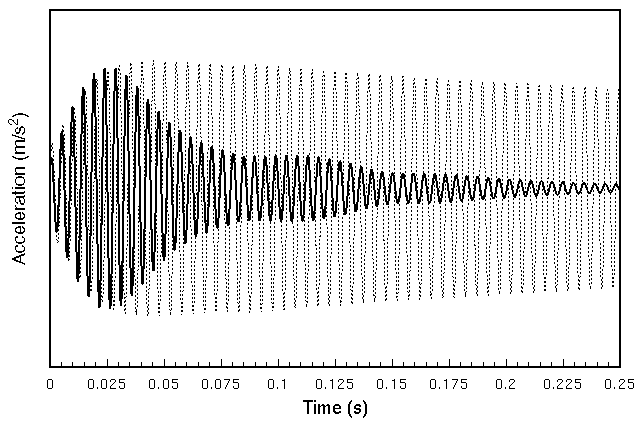 | I'm still working on the contents of this page. |  |
 | I'm still working on the contents of this page. |  |
Of greater interest to me, because of the courses I teach in acoustics and vibration, is a bat which uses a dynamic absorber (or tuned-mass-damper) to reduce vibration. I have found two such Little League bats, Easton model LX8-V and Easton model LX10E "Black Magic" both of which employ a Vibration Reduction System (V.R.S.).  Originally developed as a joint venture between Easton and engineers at Rousch Anatrol[4] this vibration reduction is obtained by mounting a metal mass in a rubber support inside the barrel at about the midpoint of the bat. The mass and the stiffness of the rubber support were chosen so that the natural frequency of the mass-spring absorber exactly matches the frequency of the first bending vibrational mode of the bat. Then, because of the action of this tuned-mass-damper, when the bat is excited by an impact the mass-spring absorber vibrates and the bat experiences almost no vibration at that specific frequency.
Originally developed as a joint venture between Easton and engineers at Rousch Anatrol[4] this vibration reduction is obtained by mounting a metal mass in a rubber support inside the barrel at about the midpoint of the bat. The mass and the stiffness of the rubber support were chosen so that the natural frequency of the mass-spring absorber exactly matches the frequency of the first bending vibrational mode of the bat. Then, because of the action of this tuned-mass-damper, when the bat is excited by an impact the mass-spring absorber vibrates and the bat experiences almost no vibration at that specific frequency.
The figure below shows the vibration of the Easton LX8-V bat with V.R.S. (thick dark line) compared with a Louisville Slugger YB8 single walled aluminum bat (thin dashed line). The bats were hung by the handle from rubber bands, and an accelerometer was attached to the end of the barrel. A baseball was used to strike the bat at the end of the barrel, away from the sweet spot - so as to simulate a "bad" hit. As can be seen from the figure, the vibration of both bats initially grows after the impact, reaching a maximum amplitude. Then the vibration of the bat with the dynamic absorber dies away quite quickly while the vibration of the "normal" aluminum bat decays very slowly. In our acoustics laboratory I've been measuring the damping ratios of a variety of Little League bats and have found that the first bending mode for wood bats usually has a Q value (quality factor) around 100 while the Q value for the first bending mode for aluminum bats (single-walled) is around 1000-3000. The Easton LX8-V with V.R.S. has a Q factor of about 50, indicating that the dynamic absorber does a very good job of reducing the vibration quickly.

[1] J. Braham, "Keep your eye on the bat," Machine Design, 69(13), 56-66 (July 10, 1997)
[2] "Batter up! Piezo dampers take the sting out of swing," Machine Design, 70(15), 46-47 (August 20, 1998)
[3] J. R. Fricke, "Lodengraf Damping - An Advanced Vibration Damping Technology," Sound and Vibration, 34(7) 22-27 (2000)
[4] C. Holden, "Beating Those Vibration Blues," Science Magazine, 254, 1290-1291 (November 29, 1991)